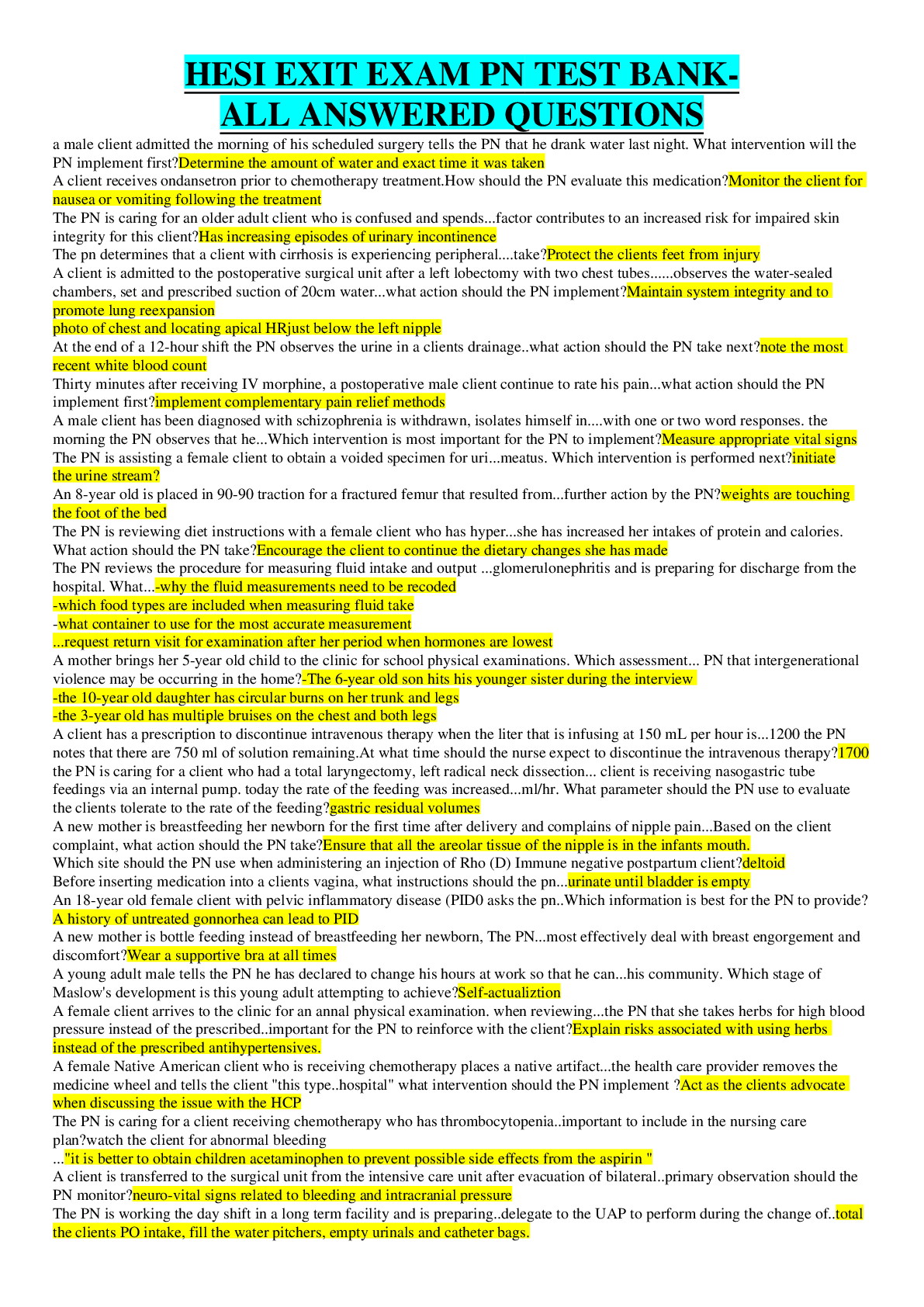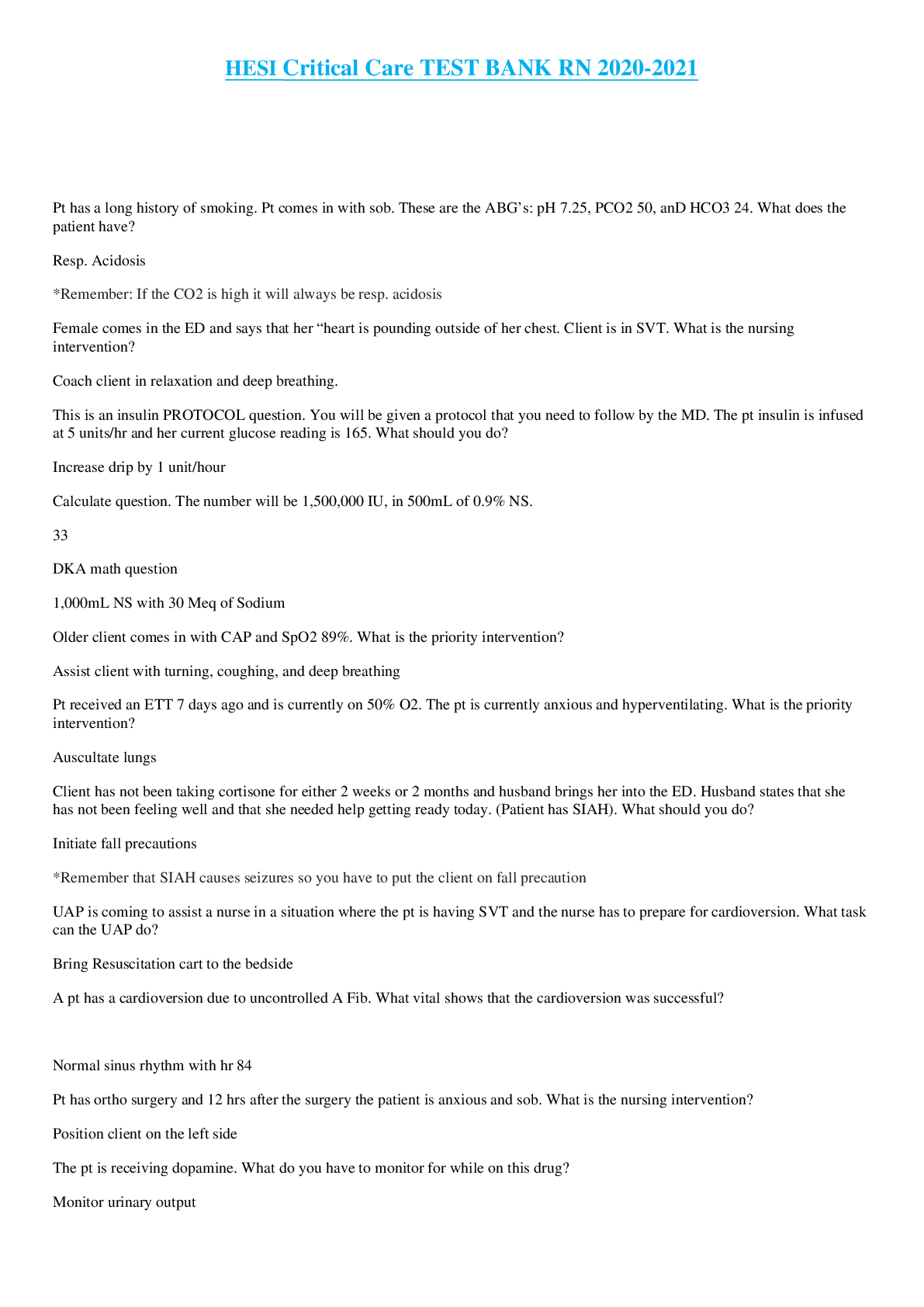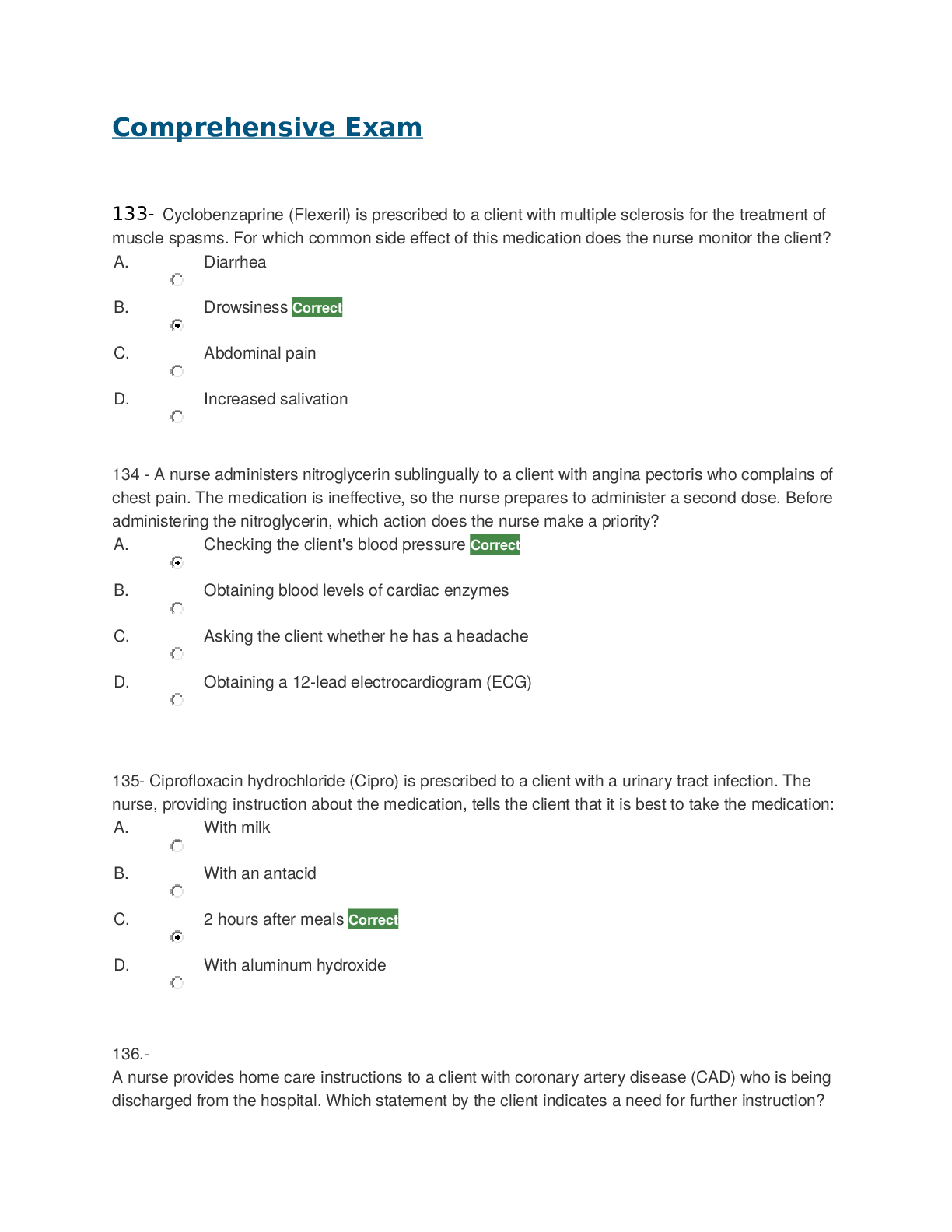HESI PEDIATRICS REVIEW (Questions and Answers with Rationale)
Document Content and Description Below
HESI PEDIATRICS REVIEW (Questions and Answers with Rationale) 1. When caring for a child with congenital heart disease and polycythemia, which nursing action has the highest priority? A. Adminis... tering oxygen therapy continuously B. Restricting fluids as ordered C. Maintaining adequate hydration D. Maintaining digoxin levels Rationale: The key word in this question is polycythemia. Hydration decreases blood viscosity and the risk for thrombus formation, the most common complication of polycythemia. Options A and D are nursing interventions for the cardiac client but do not treat polycythemia. Fluid intake should be increased, not restricted. 2. The nurse is preparing a teaching plan for the mother of a child who has been diagnosed with celiac disease. Choosing which lunch will be within the therapeutic management of a child with celiac disease? A. Turkey salad, milk, and oatmeal cookies B. Baked chicken, coleslaw, soda, and frozen fruit dessert C. Tuna salad sandwich on whole wheat bread, milk, and ice cream D. Turkey sandwich on rye bread, orange juice, and fresh fruit Rationale: A child with celiac disease is managed on a gluten-free diet, which eliminates food products containing oats, wheat, rye, or barley. 3. A 7-month-old male infant diagnosed with spastic cerebral palsy is seen by the nurse in the clinic. Which statement by the parent warrants immediate intervention by the nurse? A. “My son often chokes while I am feeding him.” B. “Is it normal for my child’s legs to cross each other?” C. “He gets stiff when I pull him up to a sitting position.” D. “My 4-year-old son is jealous of his little brother.” Rationale: Airway obstruction is always a priority when caring for any client. Options B and C are characteristics of spastic cerebral palsy and may involve one or both sides. These children have difficulty with fine motor skills, and attempts at motion increase abnormal postures. Option D is an expected behavior and may need to be addressed, but it is not a priority over choking. 4. A child is admitted to the hospital for confirmation of a diagnosis of acute lymphoblastic leukemia. During the initial nursing assessment, which symptoms will this child most likely exhibit? (Select all that apply.) A. Bone pain B. Tremors C. Nystagmus D. Abdominal distention E. Pallor Rationale: Options A and E list the most common presenting symptoms of leukemia. Leukemic cells invade the bone marrow, gradually causing a weakening of the bone and a tendency toward pathologic fractures. As leukemic cells invade the periosteum, increasing pressure causes severe pain and anemia results from decreased erythrocytes, causing pallor. Options B and C could be associated with central nervous system disorders. Option D commonly occurs in children but is not specific for leukemia. 5. The nurse is caring for a child with intussusception who is scheduled for a barium enema prior to a surgical procedure. Which action should the nurse take first? A. Evacuate the bowel of impacted feces. B. Administer magnesium sulfate. C. Place the child on a clear liquid diet. D. Assess the stool for white color. Rationale: Intussusception, an invagination or telescoping of one portion of the intestine into another, causes intestinal obstruction in children (usually occurs between 3 months and 5 years of age). Nonsurgical treatment is attempted with hydrostatic pressure created by barium instillation, which often reduces the area of bowel intussusception. In preparation for a barium enema, the client should first be placed on a clear liquid diet for the entire day; then magnesium sulfate is administered for bowel evacuation. A barium enema is likely to cause option A. After the enema, white stool may be seen as the body naturally removes any remaining barium. 6. The nurse should teach the parents of a child with a cyanotic heart defect to perform which action when a hypercyanotic spell occurs? A. Place the child’s head flat, with the knees on pillows above the level of the heart. B. Have the child lie on the right side, with the head elevated on one pillow. C. Allow the child to assume a knee-chest position, with the head and chest slightly elevated. D. Encourage the child to sit up at a 45-degree angle, drink cold water, and take deep breaths. Rationale: Assuming a knee-chest position with the head and chest slightly elevated will help restore hemodynamic equilibrium. Options A and B are incorrect positions and may hinder the child’s condition. Option D may cause chest pain or a vasovagal response, with resulting hypotension. 7. The nurse is teaching the parents of a 2-year-old child with a congenital heart defect about signs and symptoms of congestive heart failure. Which information about the child is most important for the parents to report to the health care provider? A. Sits or squats frequently when playing outdoors B. Exhibits a sudden and unexplained weight gain C. Is not completely toilet-trained and has some accidents D. Demonstrates irritation and fatigue 1 hour before bedtime Rationale: Sudden and unexplained weight gain can indicate fluid retention and is a sign of congestive heart failure. Option A is used by the child to reduce chronic hypoxia, especially during exercise. Option C is common; 2-year-olds are not expected to be toilet-trained. Option D is normal. 8. Prophylactic antibiotics are prescribed for a child who has mitral valve damage. The nurse should advise the parents to give the antibiotics prior to which occurrence? A. Adjustment of orthodontic appliances or braces B. Loss of deciduous teeth (baby teeth) C. Urinary catheterization D. Insect bites Rationale: Prophylactic antibiotics are usually prescribed prior to any invasive procedure for children who have valvular damage. Of the choices listed, only urinary catheterization is an invasive procedure. Options A, B, and D are not invasive and do not require administration of prophylactic antibiotics. 9. A 7-month-old infant with a rotavirus causing severe diarrhea is admitted for treatment. Which action should the nurse take first? A. Obtain a scale to weigh the infant’s diapers. B. Instruct the mother to offer Pedialyte regularly. C. Insert an intravenous (IV) line and begin IV fluids. D. Obtain a stool specimen for analysis. Rationale: An infant with severe diarrhea is at high risk for dehydration, so the nurse’s priority is to initiate IV fluids to rehydrate the infant. Options A, B, and D can then be implemented as needed. 10. The nurse admits a child to the intensive care unit with a possible diagnosis of Wilms tumor. What is the most important safety precaution for child? A. Maintain NPO status. B. Limit visitors to the immediate family. C. Place a do not palpate abdomen sign on head of bed. D. Encourage ambulation in the pre-operative period. Rationale: Protect child from injury; place a sign on bed stating “no abdominal palpation” (to prevent accidental fragmentation and dislodging into the abdominal cavity). The other option choices are not relevant at this time. 11. The nurse is taking the family history of a 2-year-old child with atopic dermatitis (eczema). Which statement by the mother is most important in formulating a plan of care for this child? A. “Our first child was born with a cleft lip.” B. “We are very careful not to get sunburns in our family.” C. “My first child sometimes got a diaper rash.” D. “My husband and our daughter are both lactose-intolerant.” Rationale: Environmental exposure to allergens (milk) and a positive family history for milk allergies are important data in planning care of the child with atopic dermatitis because milk allergies can contribute to the child’s outbreaks. Option A is not a contributing factor. Option B is an environmental factor in other skin diseases but does not have a strong correlation with eczema in children. Option C is not unusual and occurs in the diaper area, whereas atopic dermatitis occurs most often on the face and extensor aspects of the arms and legs. 12. A mother calls the clinic because her 6-year-old son, who has been taking prescribed antibiotics for 7 of the previous 10 days, continues to have a cough that she reports is worsening. Further questioning by the nurse reveals that the cough is nonproductive. What is the nurse’s best instruction to the mother? A. Watch the boy a few more days and see if the cough begins to produce sputum. B. The full 10-day course of antibiotics must be completed before effectiveness can be evaluated. C. Give the child plenty of fluids and an over-the-counter cough suppressant. D. Bring the child to the clinic today for an examination related to the cough. Rationale: The child should be evaluated as soon as possible for pneumonia. Antibiotics usually improve symptoms during the first few days of treatment but should be continued for the full prescribed course. A continued cough after 7 days of antibiotic treatment may indicate an infectious process in the lower lungs, which could cause a nonproductive cough. Children with pneumonia can deteriorate unexpectedly and rapidly and can become seriously ill, with no sputum production. Option B delays evaluation too long. Although giving fluids is advisable, cough suppressants might mask symptoms of a serious condition. 13. The nurse is assessing a male adolescent client’s knowledge of contraception. The teen states, “I have all the info I need.” What is the best response by the nurse? A. “Tell me what you know about birth control.” B. “Do you know how to apply a condom?” C. “Teen pregnancy should not be taken lightly.” D. “You need to visit with your guidance counselor.” Rationale: Teens often obtain information from peers, which may not be accurate. Knowing the source of the information may assist the nurse in evaluating the information that the teenager has regarding contraception. It would be best for the nurse to ask a more general question, such as option A. Option B is narrow in focus. Options C and D are blocks to any further communication. 14. The nurse is examining a male child experiencing an exacerbation of juvenile rheumatoid arthritis (JRA) and notes that mobility is greatly reduced. What is the most likely cause of the child’s impaired mobility? A. Pathologic fractures B. Poor alignment of joints C. Dyspnea on exertion D. Joint inflammation Rationale: Joint inflammation and pain are the typical manifestations of an exacerbation of JRA. Options A, B, and C are not specifically related to JRA. 15. A father of a 5-year-old calls the nurse to report that his child, who has had an upper respiratory infection, is complaining of a headache, with a rectal temperature of 103°F/39.4°C. Which action has the highest priority? A. Determine if the child has any allergies to antibiotics. B. Instruct the parent to give the child tepid baths. C. Instruct the parent to increase the child’s fluid intake. D. Tell the parent to take the child to the emergency department. Rationale: The child is exhibiting symptoms that may indicate possible meningitis, and the parents should be encouraged to get immediate evaluation. Options A, B, and C are all valuable interventions after the client is assessed and diagnosed. .........CONTINUED [Show More]
Last updated: 1 year ago
Preview 1 out of 26 pages

Reviews( 0 )
Document information
Connected school, study & course
About the document
Uploaded On
Jan 27, 2021
Number of pages
26
Written in
Additional information
This document has been written for:
Uploaded
Jan 27, 2021
Downloads
0
Views
45

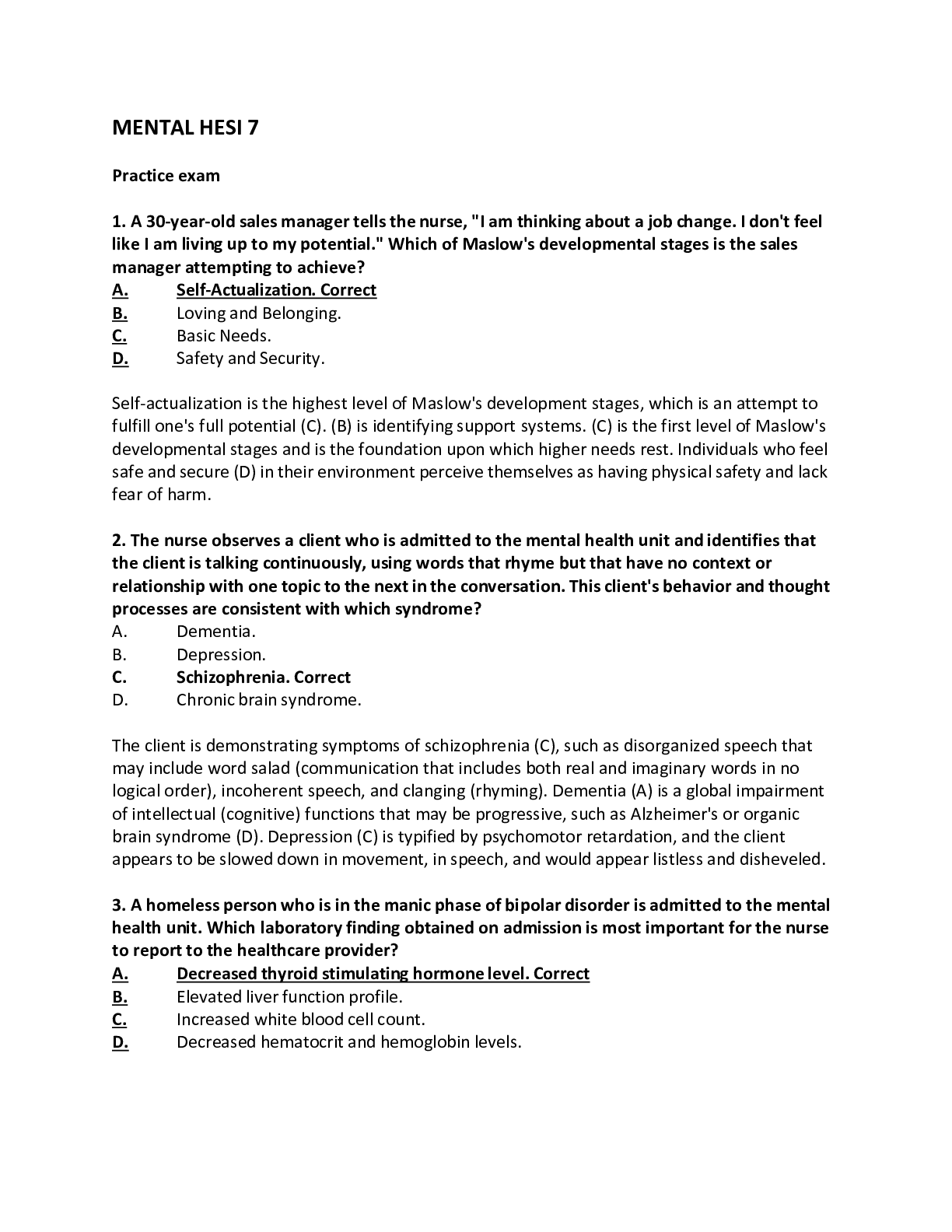
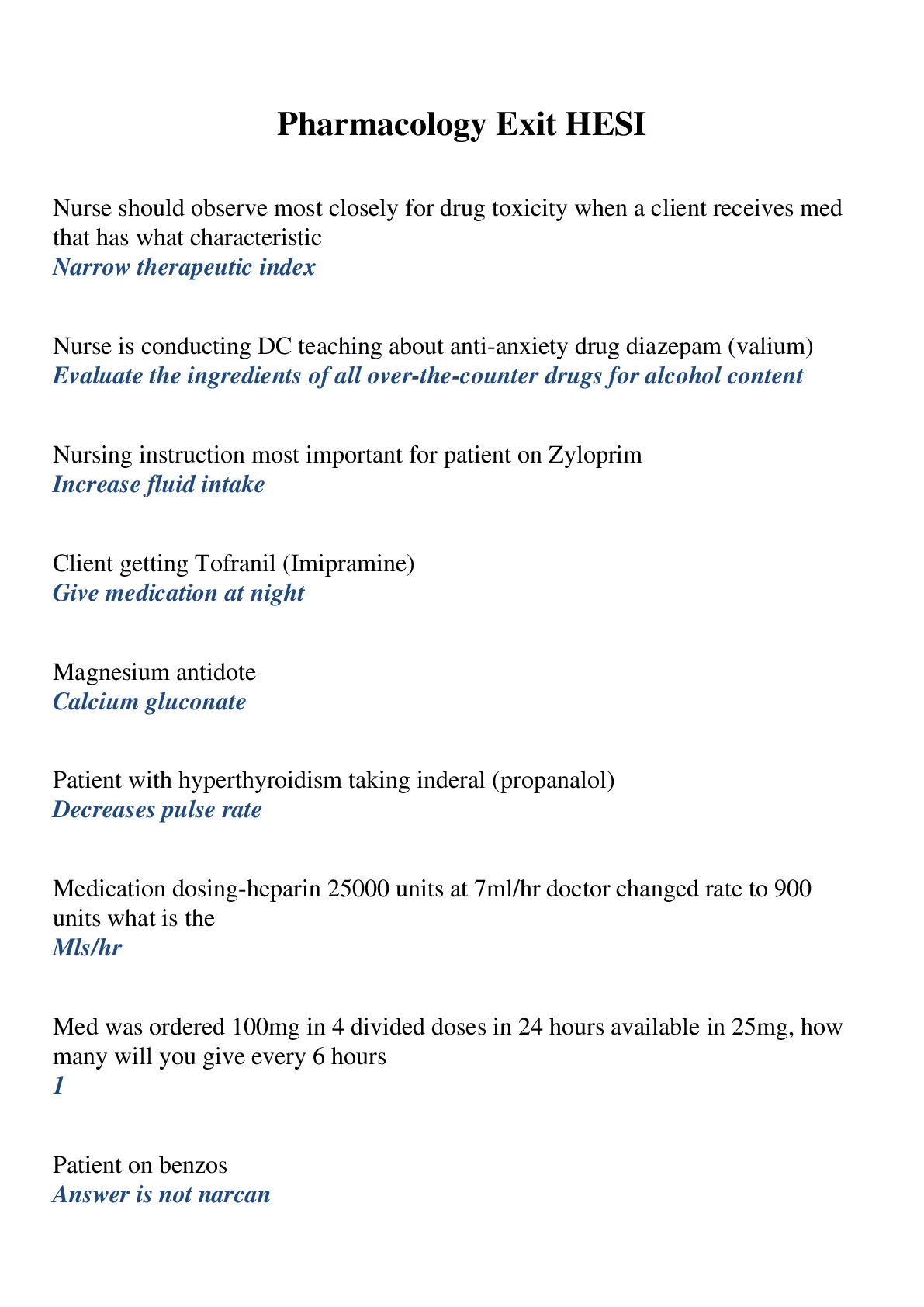
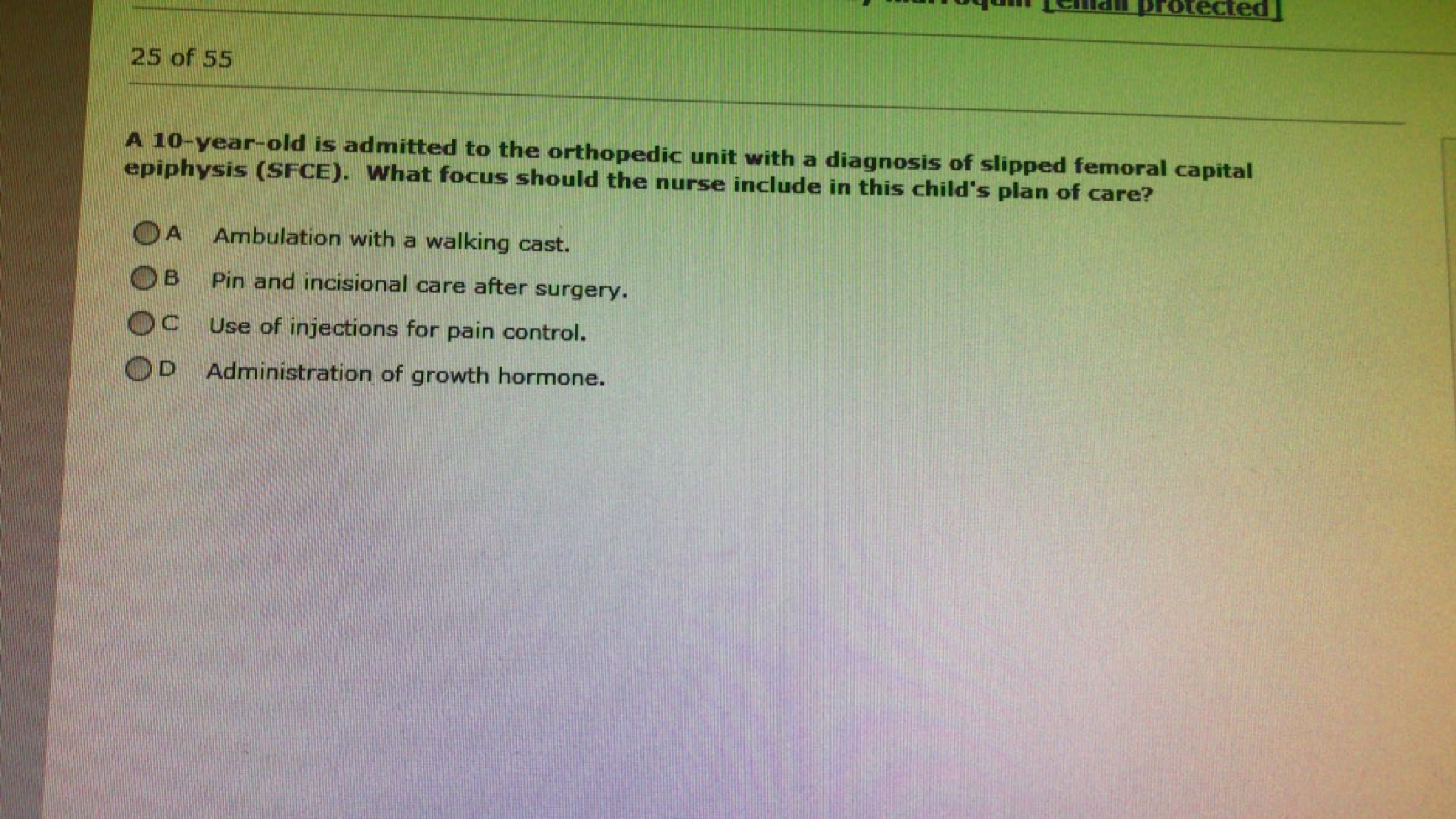
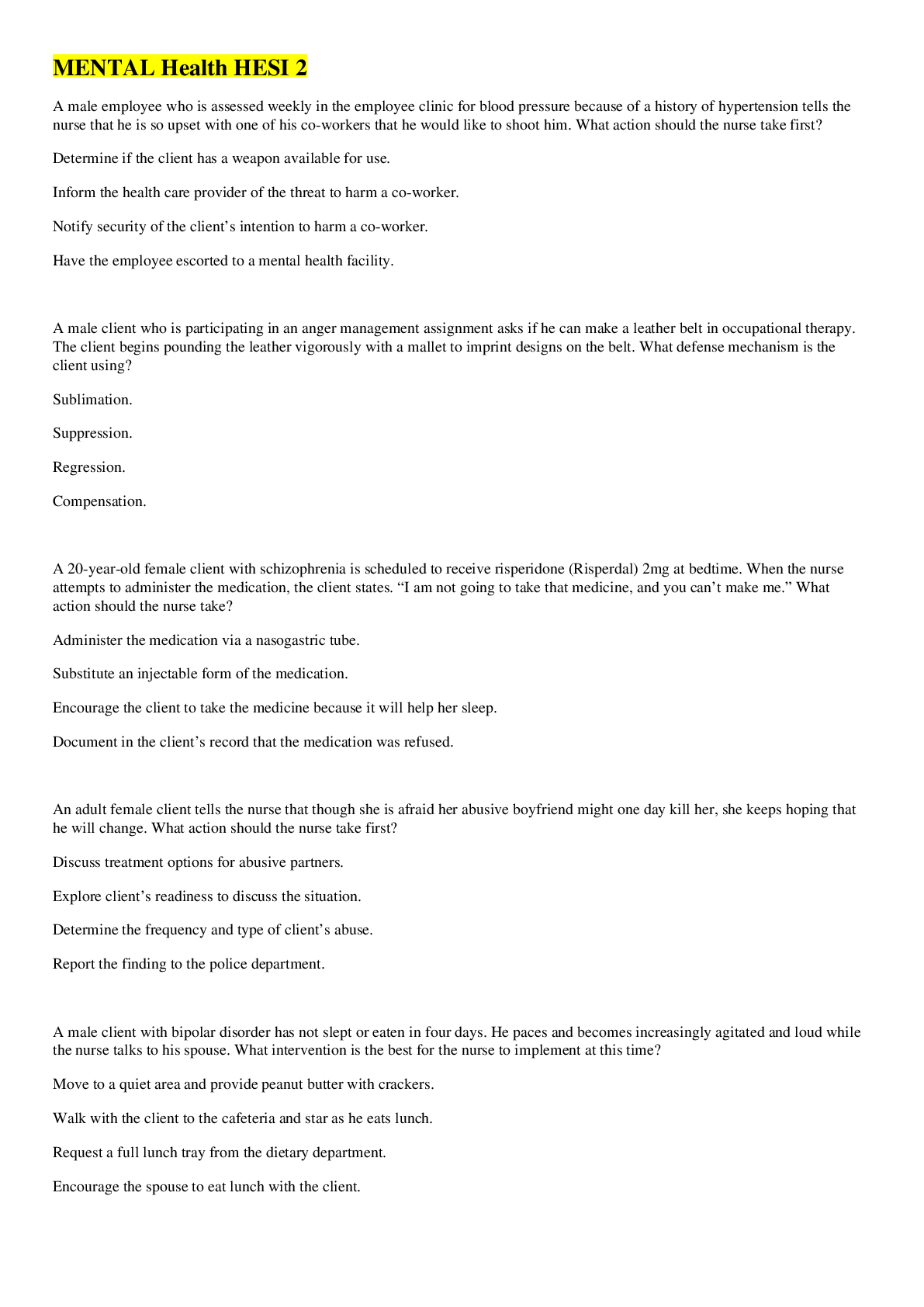
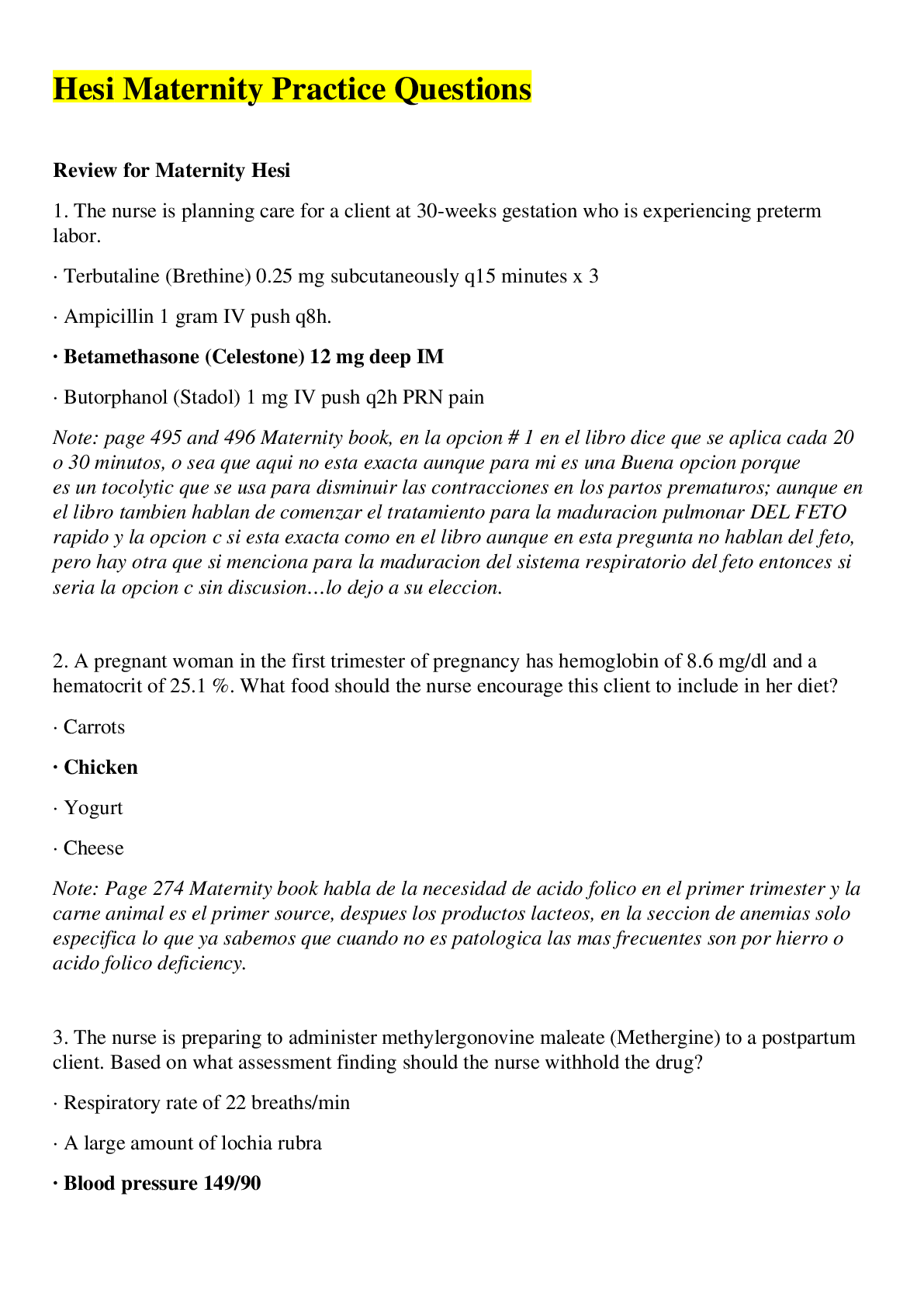
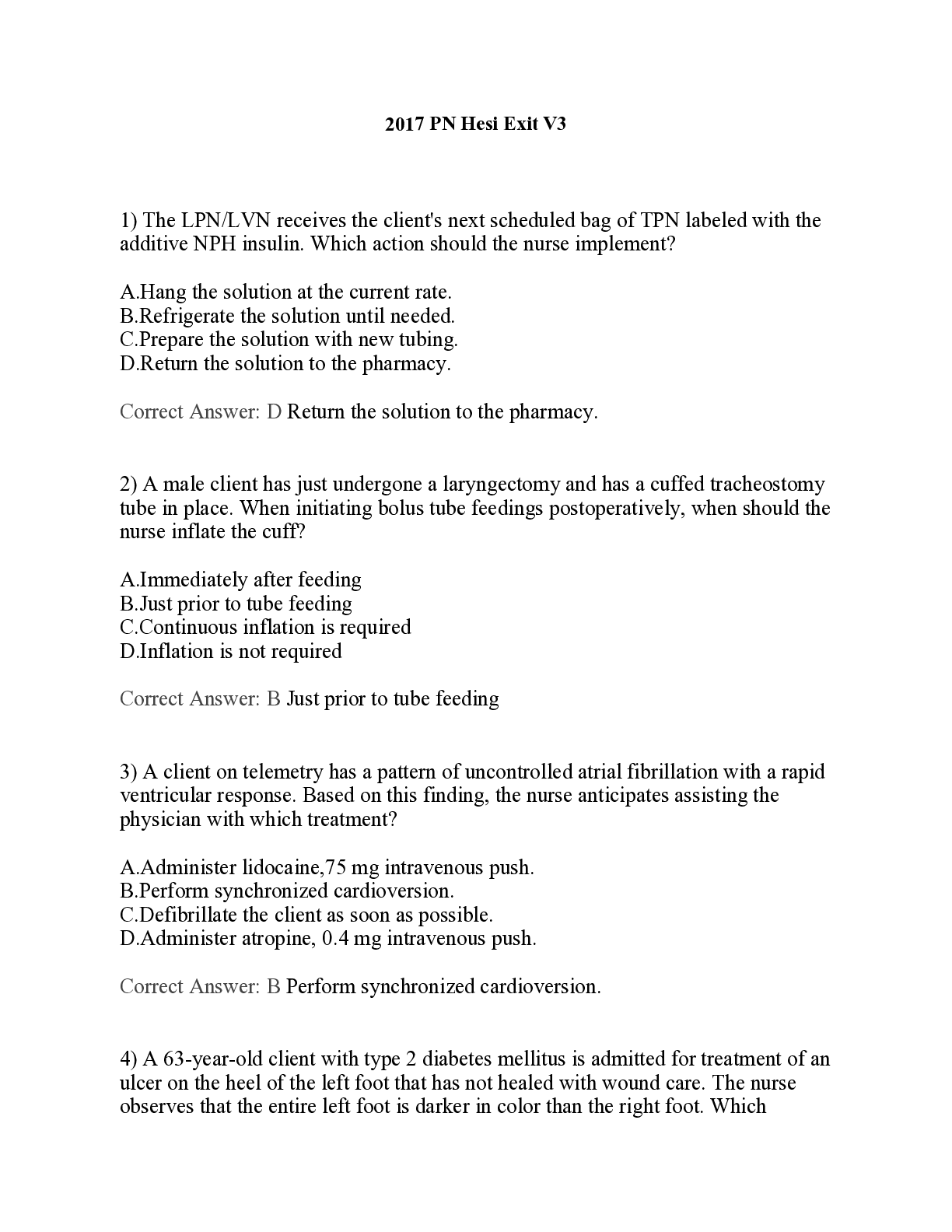
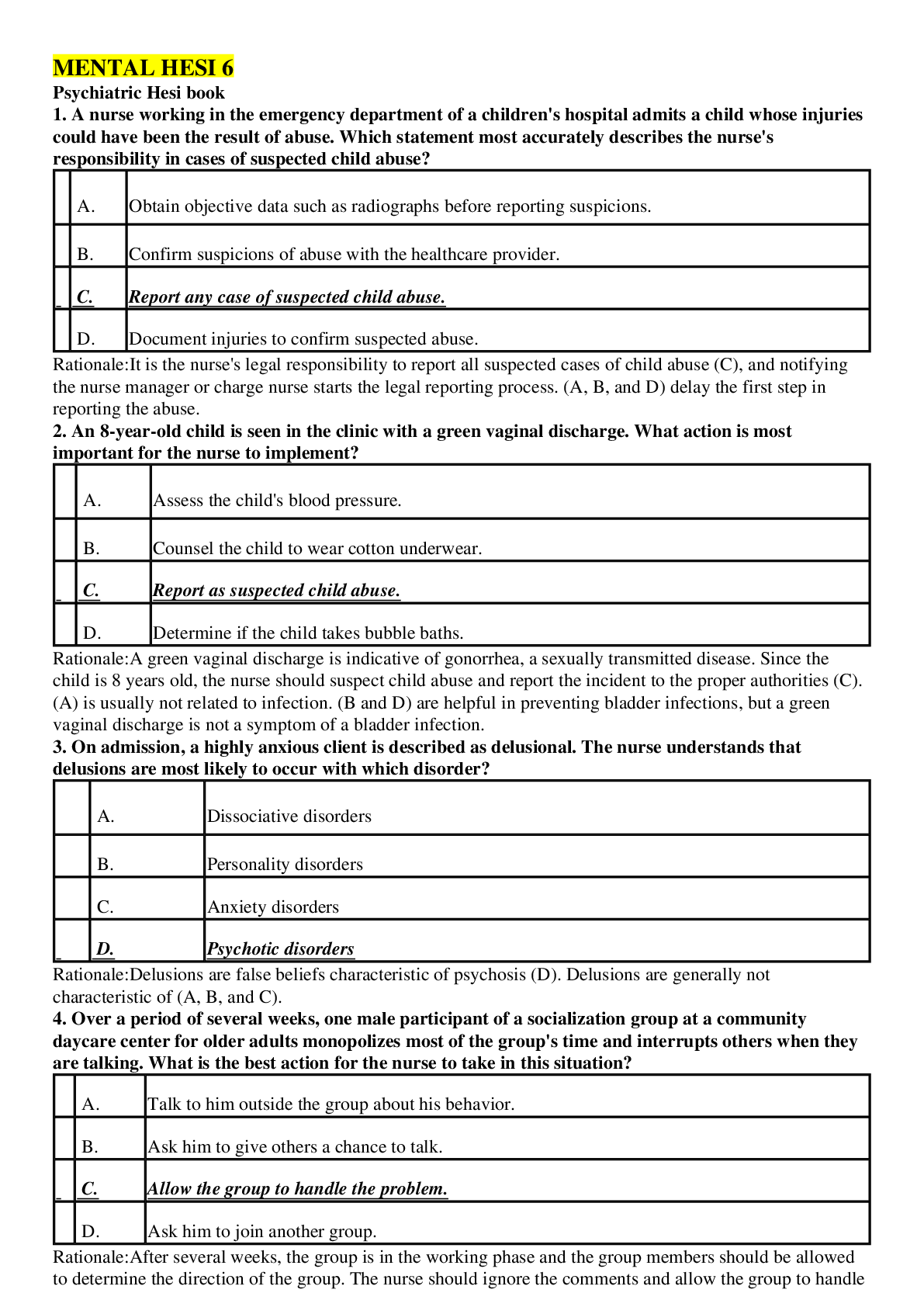
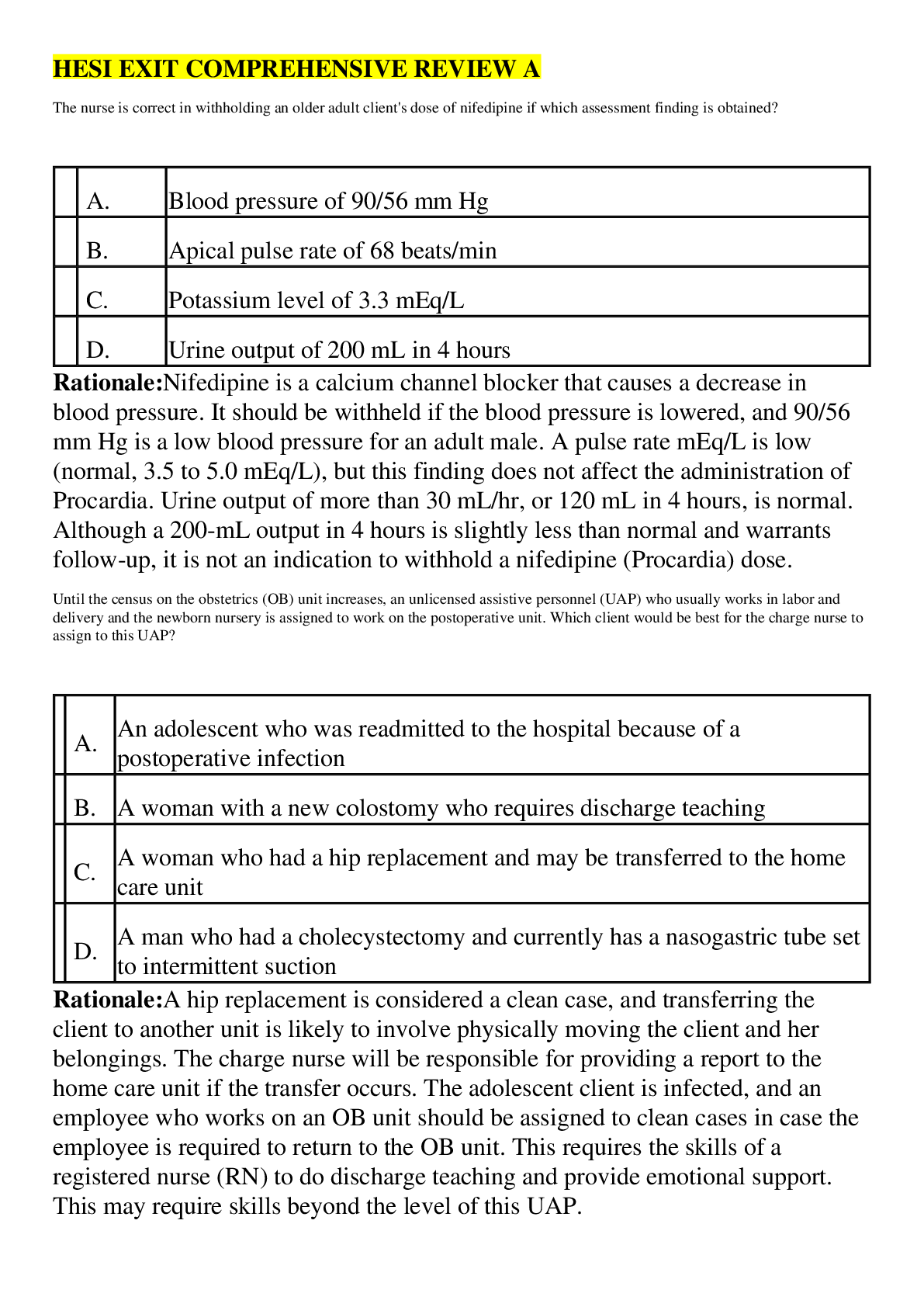
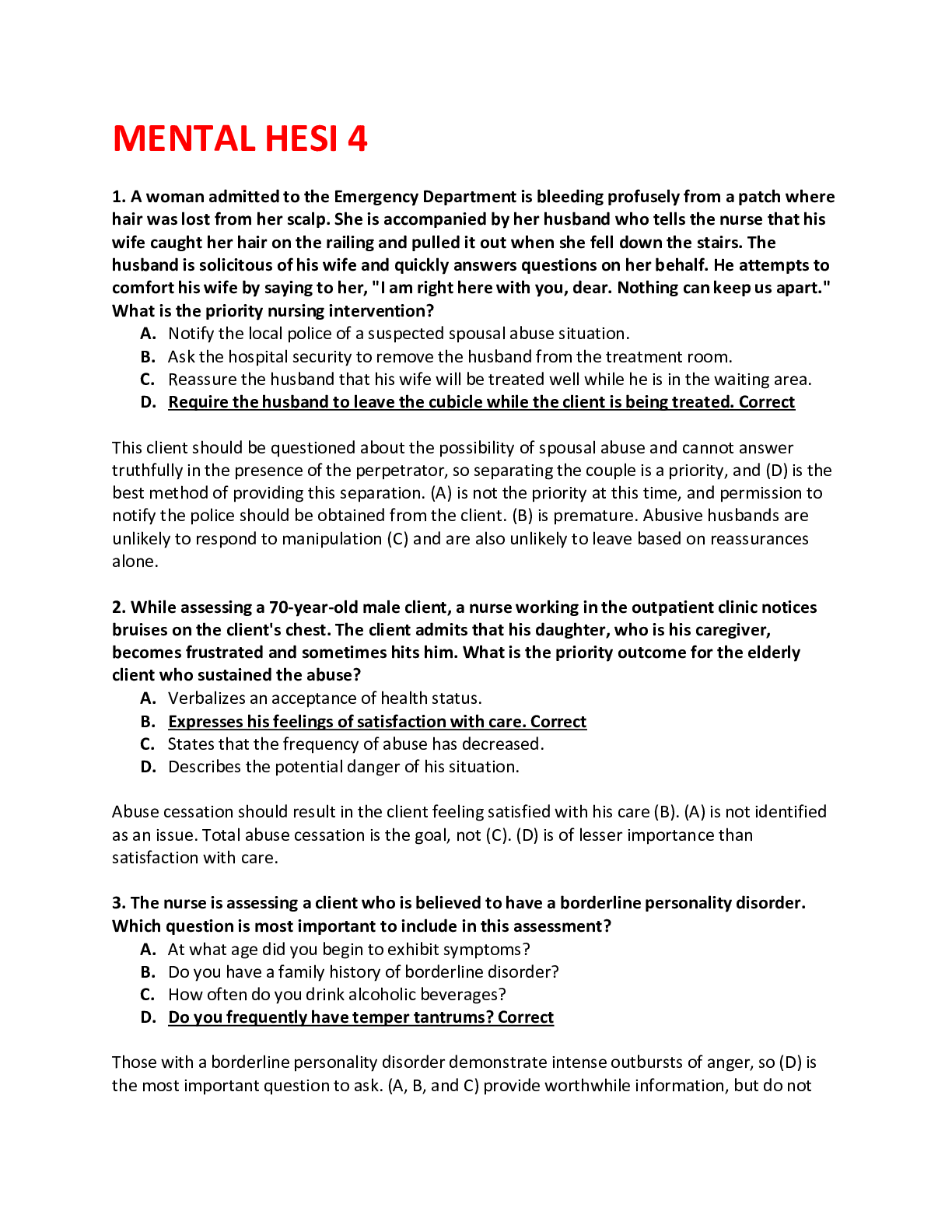
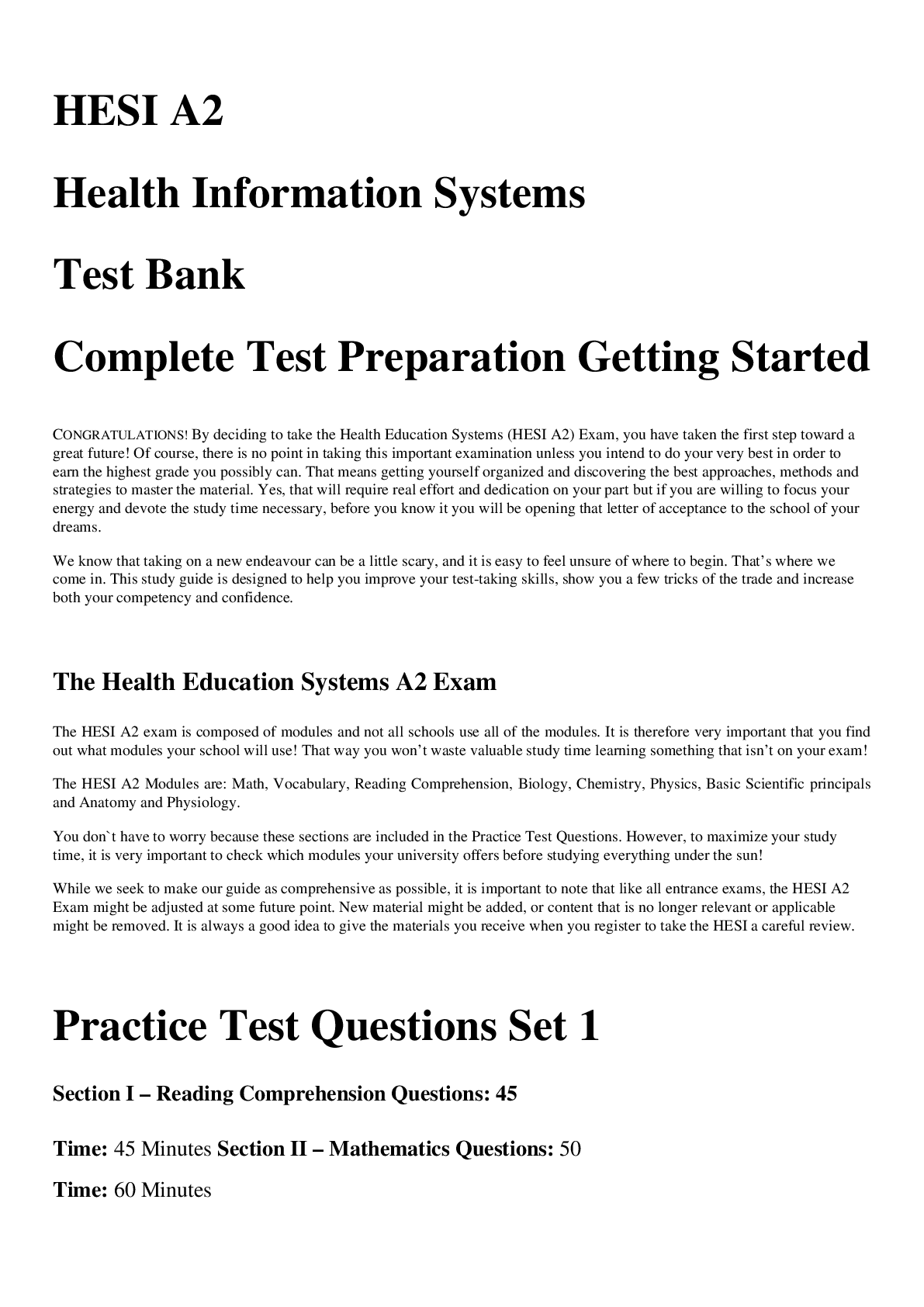
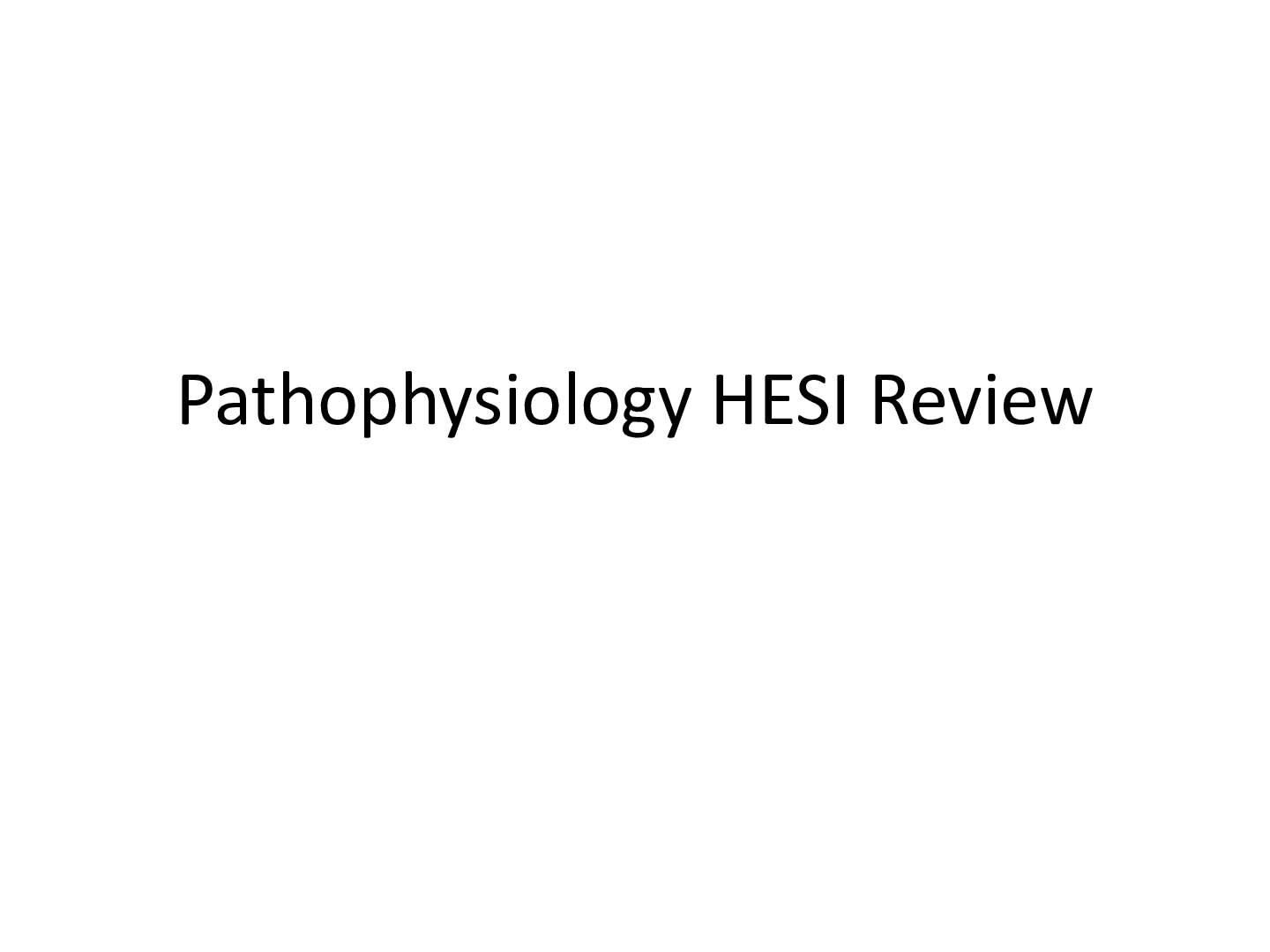
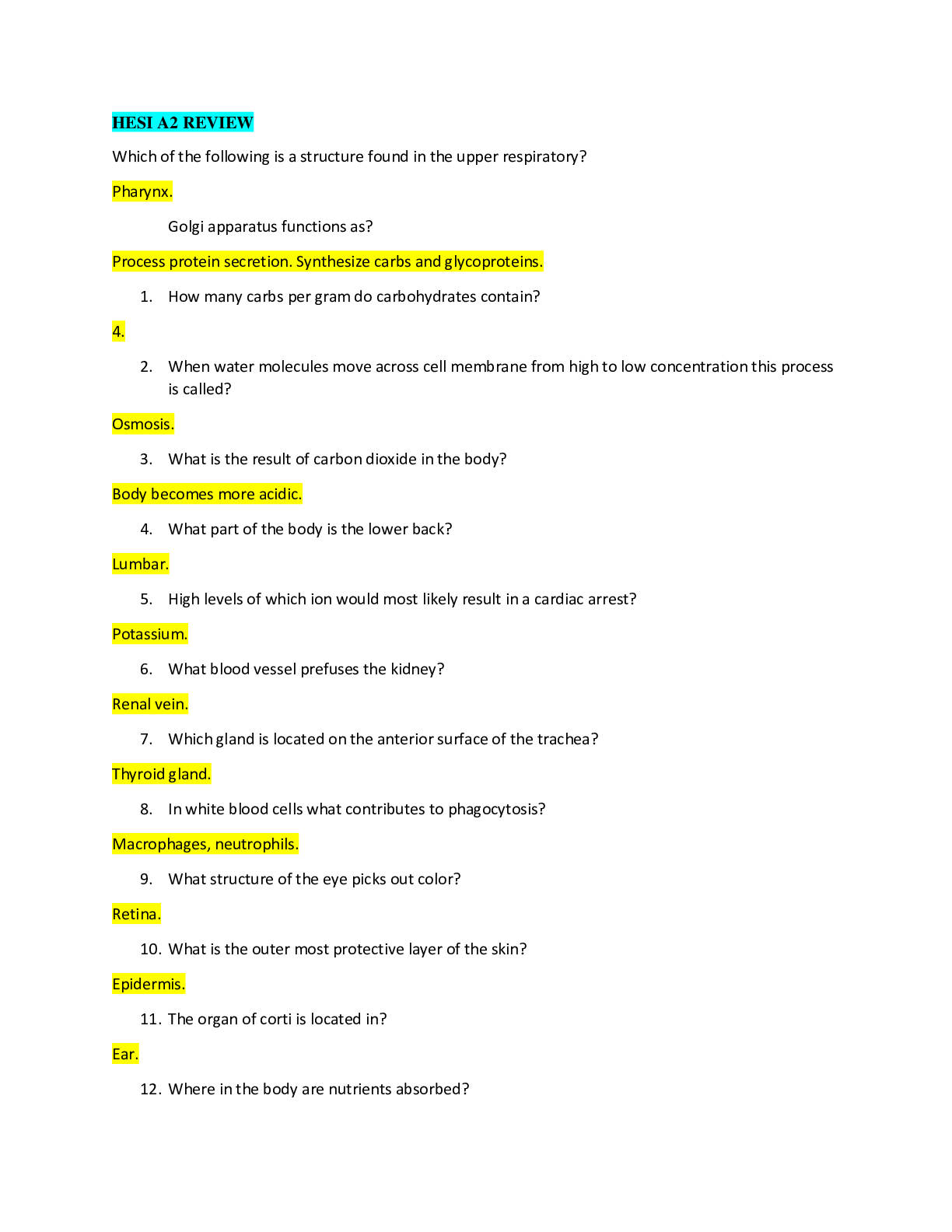
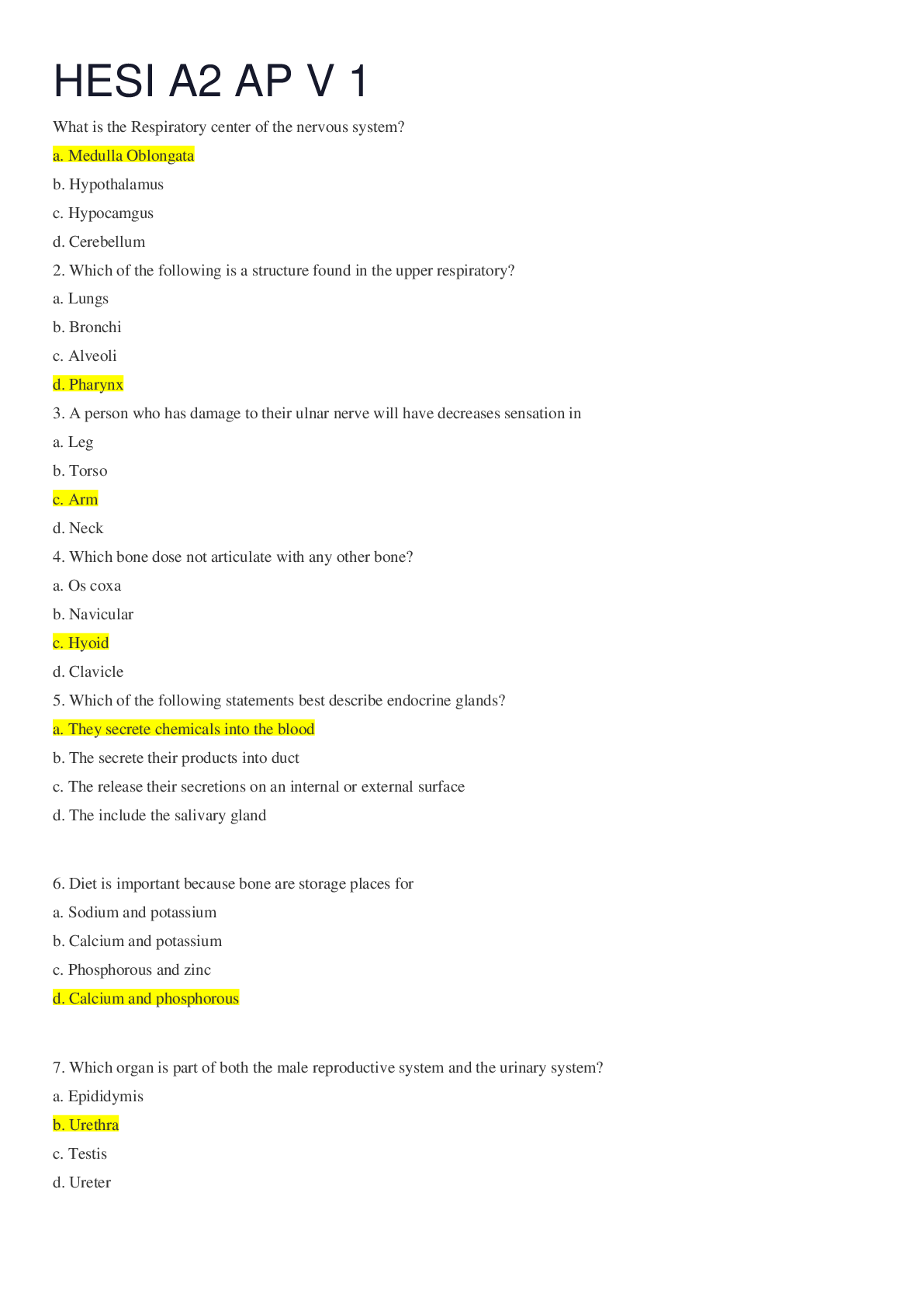


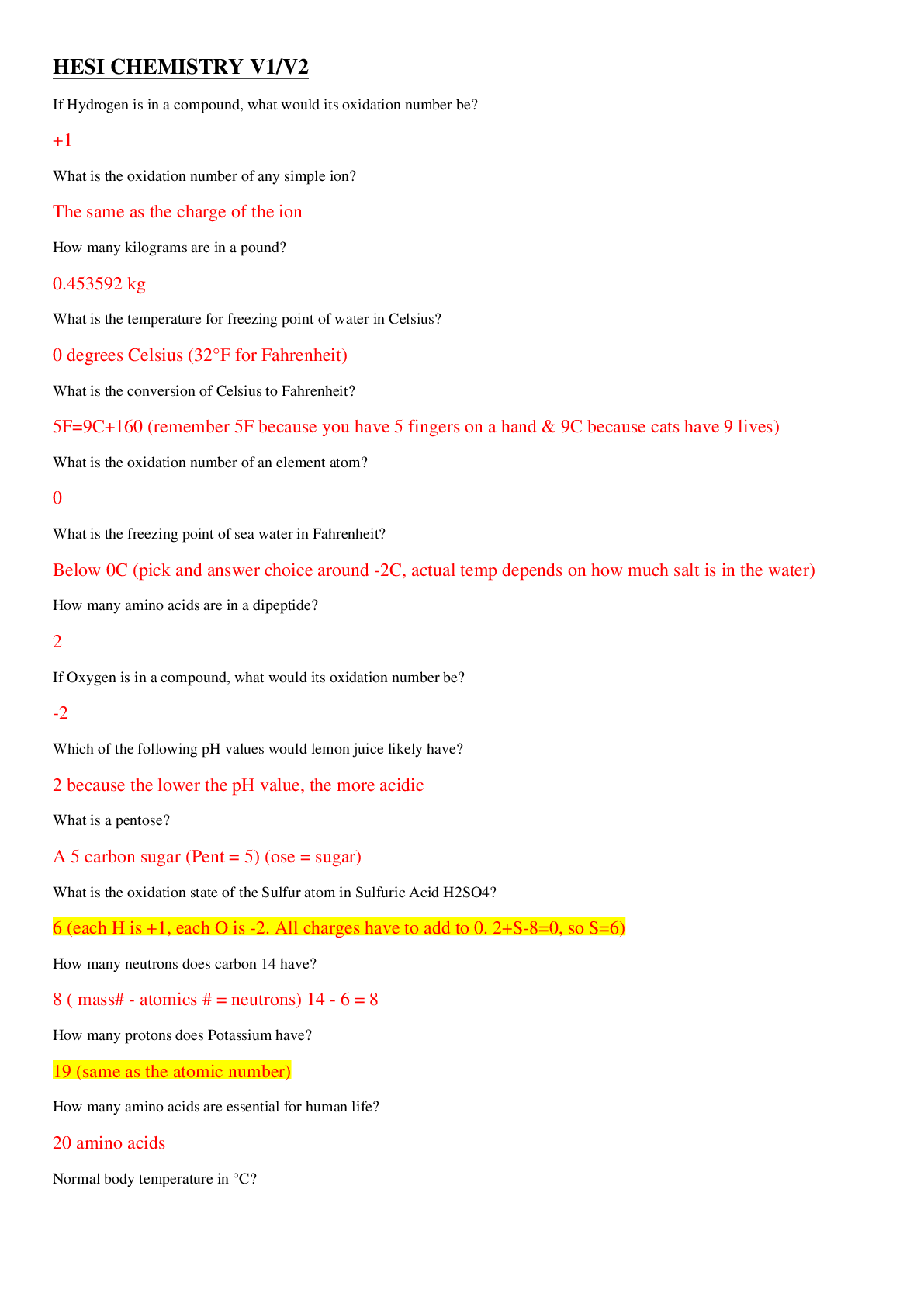
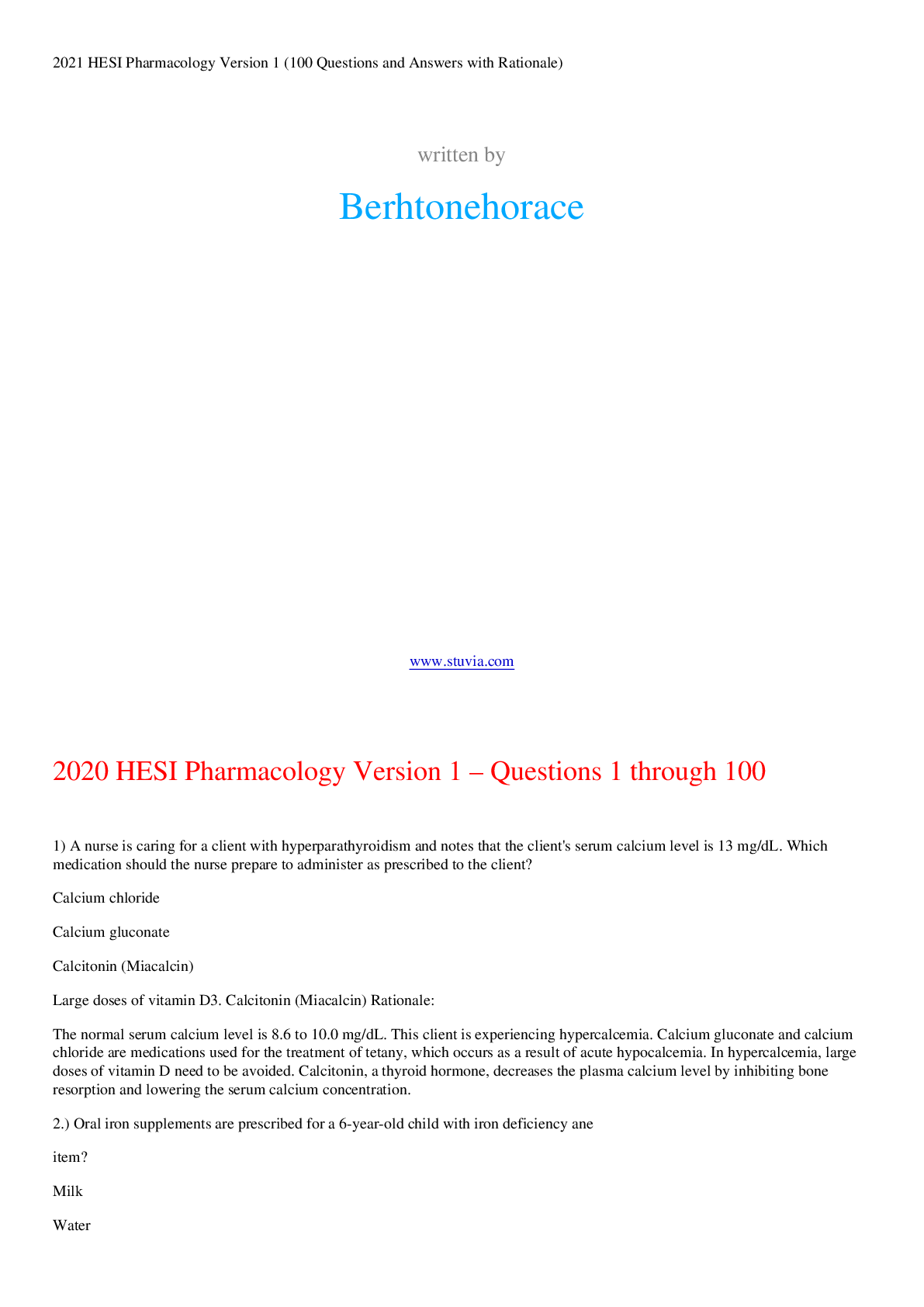


 Latest 2020 -2021.png)


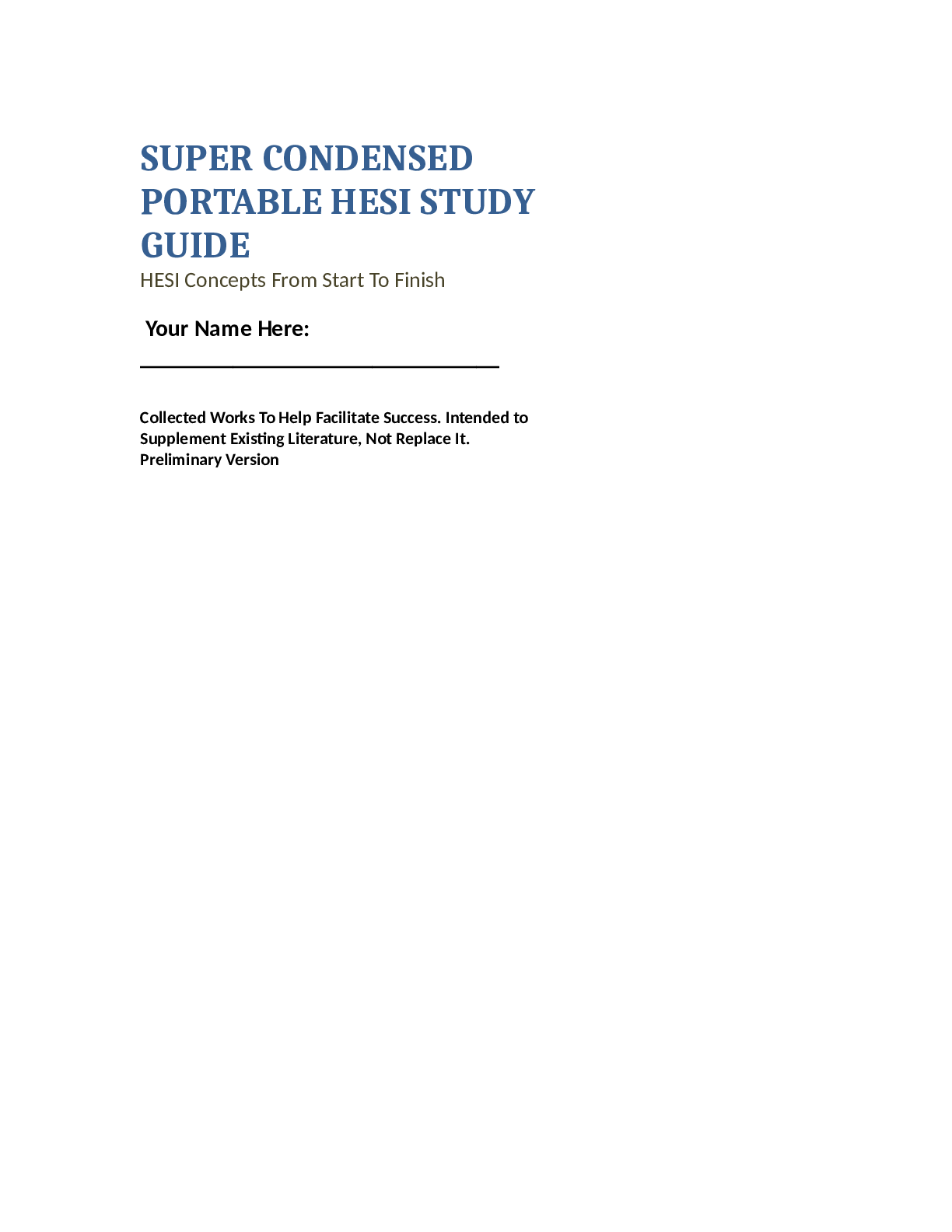




 (1).png)



